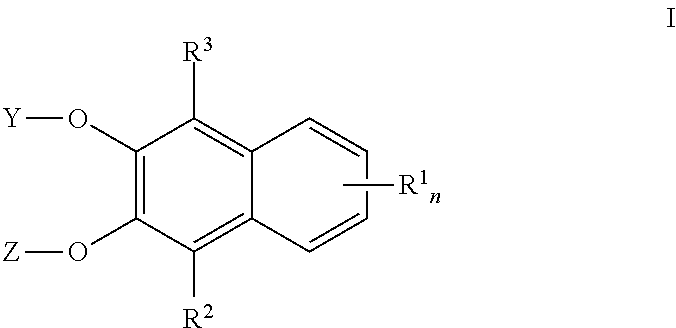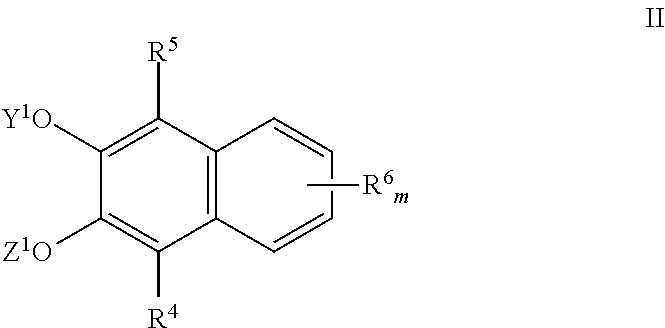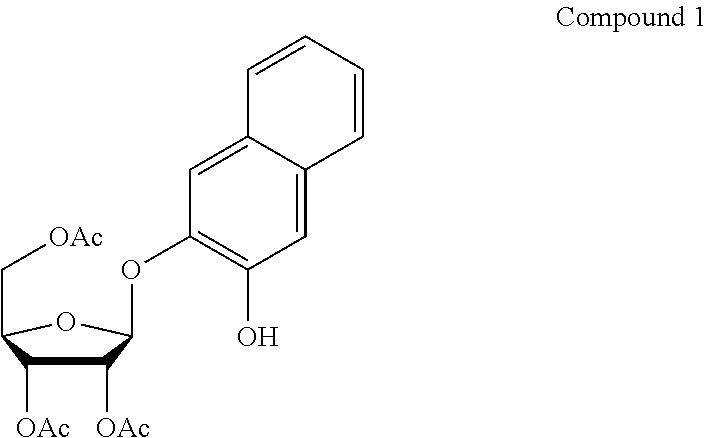Naphthalene derived chromogenic enzyme substrates
a technology of chromogenic enzymes and substrates, which is applied in the field of artificial chromogenic enzyme substrates, can solve the problems of affecting the fluorescence of fluorogenic assays, requiring a lamp or other source of uv light, and affecting the fluorescence of all core molecules, so as to achieve the effect of improving the fluorescence and reducing the cost of production
- Summary
- Abstract
- Description
- Claims
- Application Information
AI Technical Summary
Benefits of technology
Problems solved by technology
Method used
Image
Examples
example 1
f DHN-β-D-Galactopyranoside with a Variety of Microorganisms
[0062]DHN is inexpensive and readily available commercially. We found that novel glycosides of it could be prepared by standard means. Thus the protected DHN-β-D-galactopyranoside (7) was made by coupling acetobromogalactose with DHN in acetone-water in the presence of sodium hydroxide. After work-up, deprotection in methanol containing a catalytic quantity of sodium methoxide furnished the desired DHN-β-D-galactopyranoside (8) as an off-white solid. Details of the synthesis are given below in syntheses 7 and 8.
[0063]This compound was tested on agar plates by multi-point inoculation. The plates were made from Columbia agar (Oxoid, Basingstoke, UK) (100 ml) supplemented with ferric ammonium citrate (FAC) (50 mg). After the agar had been autoclaved (121° C.) and cooled to 50° C., a filter sterilized solution of the substrate (8) (30 mg) dissolved in N-methylpyrrolidone (NMP) (200 μL) was added, thus giving a substrate concent...
example 2
Substrates and Cleavage by Microorganisms with a Range of Enzymatic Marker Activities
[0067]Several other DHN substrates, intended for some of the most frequently encountered hydrolase activities in diagnostic microbiology, were synthesised by the methods described below. These were the glycosides β-D-glucopyranoside (4), α-D-glucopyranoside (6), α-D-galactopyranoside (10) and N-acetyl-β-D-glucosaminide (15), the esterase substrate DHN-dicaprylate (16) and the phosphatase substrate, DHN-phosphate disodium salt (17). DHN-β-D-ribofuranoside (2) was also made. When evaluated in the same manner as DHN-β-D-galactopyranoside (8), in general these substrates were hydrolysed according to the known enzyme profiles of the test strains (Tables 2 and 3). However, DHN-β-D-ribofuranoside (2) (Table 2) was of particular interest.
[0068]
TABLE 2DHN-β-D-DHN-α-D-DHN-α-D-DHN-N-acetyl-β-D-ribofuranoside 2galactopyranoside 10glucopyranoside 6glucosaminide 15OrganismColourColourColourColour1Escherichia coli...
example 3
lucuronide Substrates and their Testing on Various Microorganisms
[0071]Tube or liquid media containing the fluorogenic compound MUG (4-methylumbelliferyl β-D-glucuronide) are extensively used to detect E. coli. Often these systems also contain the substrate ONPG for the detection of β-D-galactosidase activity and therefore total coliforms. The media Colitag® (CPI international, Santa Rosa, USA) and ColiLert® (Idexx Laboratories, Westbrook, USA) both utilise MUG plus ONPG for detecting E. coli and total coliforms. The disadvantage of MUG is that a UV source is required to visualise the fluorescence associated with E. coli. It would be an advantage to have a chromogenic glucuronide that can detect E. coli with incident visible light. Accordingly, the novel compound DHN-β-D-glucuronide (12) was prepared in both its cyclohexylammonium salt form (12a) (hereinafter referred to as the CHA salt) and its sodium salt form (12b). In the preliminary evaluation against twenty different microorga...
PUM
| Property | Measurement | Unit |
|---|---|---|
| concentration | aaaaa | aaaaa |
| concentration | aaaaa | aaaaa |
| temperature | aaaaa | aaaaa |
Abstract
Description
Claims
Application Information
 Login to View More
Login to View More - R&D
- Intellectual Property
- Life Sciences
- Materials
- Tech Scout
- Unparalleled Data Quality
- Higher Quality Content
- 60% Fewer Hallucinations
Browse by: Latest US Patents, China's latest patents, Technical Efficacy Thesaurus, Application Domain, Technology Topic, Popular Technical Reports.
© 2025 PatSnap. All rights reserved.Legal|Privacy policy|Modern Slavery Act Transparency Statement|Sitemap|About US| Contact US: help@patsnap.com



